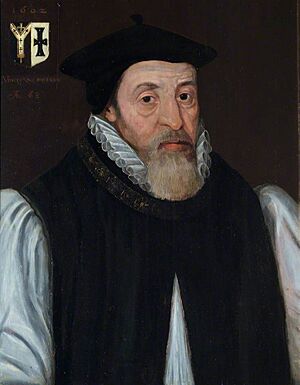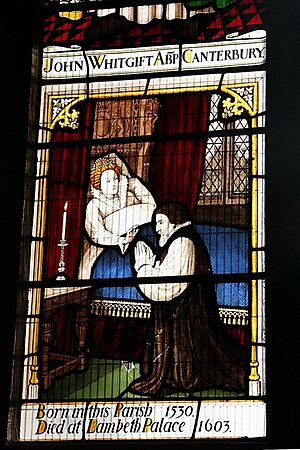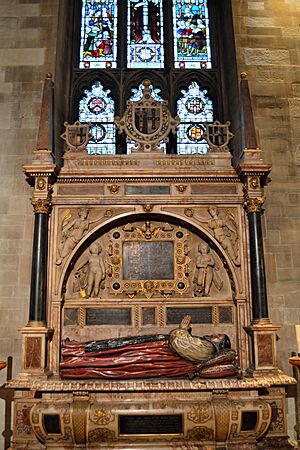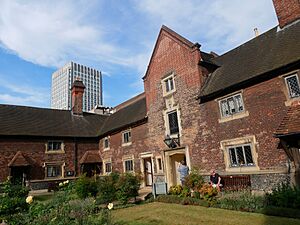John Whitgift facts for kids
Quick facts for kids The Most Reverend and Right Honourable John Whitgift |
|
|---|---|
| Archbishop of Canterbury | |
 |
|
| Church | Church of England |
| Diocese | Canterbury |
| Enthroned | August 1583 |
| Reign ended | 29 February 1604 |
| Predecessor | Edmund Grindal |
| Successor | Richard Bancroft |
| Orders | |
| Ordination | 1560 |
| Consecration | 21 April 1577 by Edmund Grindal |
| Personal details | |
| Born | c. 1530 Great Grimsby, Lincolnshire, England |
| Died | 29 February 1604 (aged 73/74) Lambeth, London, England |
| Buried | Croydon, Surrey |
| Signature | |
John Whitgift (born around 1530 – died February 29, 1604) was a very important leader in the Church of England. He served as the Archbishop of Canterbury from 1583 until his death. This was the highest position in the English Church.
Whitgift was known for being very welcoming and generous. He sometimes traveled with a large group of people, even as many as 800 horses! His ideas about religion were often debated by others.
Contents
Early Life and Education
John Whitgift was the oldest son of Henry Whitgift, a merchant. He was born in Grimsby, England, likely between 1530 and 1533. His family may have come from a nearby village called Whitgift.
His uncle, Robert Whitgift, who was an abbot (a leader in a monastery), helped with John's early schooling. John was sent to St Anthony's School in London. In 1549, he started studying at Queens' College, Cambridge. A year later, he moved to Pembroke Hall, Cambridge, where John Bradford, a famous religious figure, was his teacher. In 1555, John Whitgift became a fellow at Peterhouse.
His Time at Cambridge University
In 1560, John Whitgift became a priest. He worked for Richard Cox, who was the Bishop of Ely. Bishop Cox appointed him to lead the church in Teversham, near Cambridge.
In 1563, Whitgift became a professor of divinity (religious studies) at the University of Cambridge. His lectures were so good that his pay was increased. The next year, he became the Regius Professor of Divinity. He then became the head of Pembroke Hall in 1567 and Trinity College in 1570. He also helped create the university's rules, which were approved in 1570. In November of that year, he was chosen as the vice-chancellor, a top leader at the university.
John Whitgift and Francis Bacon
Whitgift taught Francis Bacon and his older brother, Anthony, at Cambridge University in the 1570s. As their teacher, Whitgift bought them important classical books by writers like Plato and Cicero.
Whitgift's strong beliefs and traditional religious teachings had a big impact on Francis Bacon. Bacon later disagreed with Whitgift's methods. He even wrote to Elizabeth I to warn her about Whitgift's efforts to remove certain preachers from churches.
Promotions and New Roles
John Whitgift's religious ideas were sometimes controversial. One relative who housed him once said she thought he was a saint but realized he was "a devil." This shows how strongly people felt about his views.
Whitgift had a famous debate with Thomas Cartwright about the rules of the Church of England. Whitgift used his power to remove Cartwright from his teaching job and his fellowship at Trinity College. In 1571, Whitgift became the Dean of Lincoln. From 1572 to 1577, he was the leader of St Margaret's church in Laceby.
In 1577, Whitgift was made the Bishop of Worcester. He also served as a vice-president of Wales when Sir Henry Sidney was away in Ireland.
Archbishop of Canterbury (1583–1604)

In August 1583, John Whitgift became the Archbishop of Canterbury. He took over from Edmund Grindal, who had been under house arrest. Whitgift strongly supported the Church of England's rules and shared Queen Elizabeth's dislike for Puritans. Puritans were a group who wanted to make the Church of England simpler and more "pure."
Whitgift worked closely with Queen Elizabeth. He created rules to deal with ministers who did not follow the church's ways. He also gained more power for the Court of High Commission, which was a special court for church matters. In 1586, he became a privy councillor, a trusted advisor to the Queen.
His actions led to the creation of the Martin Marprelate tracts. These were secret writings that strongly criticized the bishops and clergy. Whitgift worked hard to find and punish the people who printed these tracts. He also had nine leading Presbyterians arrested, including Thomas Cartwright. Although they were not found guilty of serious crimes, they agreed to stop their movement.
Whitgift took very strong actions against groups like the Brownist movement. Their secret churches in London were often raided, and members were imprisoned. Whitgift questioned them many times. He was a key person behind a law passed in 1593 that made being a Separatist Puritan a serious crime.
He also took action against other preachers who disagreed with the church, leading to their imprisonment. In 1595, Whitgift helped create the Lambeth Articles, which were a set of Calvinist beliefs. However, Queen Elizabeth ordered them to be withdrawn, saying the bishops had acted without her full permission.
Whitgift was with Queen Elizabeth when she died. He also crowned James I as the new king. He was present at the Hampton Court Conference in January 1604, where he represented the bishops.

John Whitgift died in Lambeth at the end of February 1604. He was buried in Croydon at the Parish Church of St John Baptist, which is now Croydon Minster. His monument there was mostly destroyed in a fire in 1867.
His Legacy
John Whitgift was described as being of "middle height, strong and well shaped." He had a serious face, brown skin, and black hair and eyes.
He left behind several writings that were never published. Many of his letters and rules are kept in historical records from Queen Elizabeth's time. His collected works include his controversial writings, sermons, and letters.
In his later years, Whitgift worked on improving the church. He wanted to help clergy learn more and make sure priests lived in their parishes. He also worked to improve the church courts.
Whitgift created important charitable organizations called almshouses in Croydon. These are now part of The Whitgift Foundation. This foundation helps the elderly and sick. It also runs three independent schools: Whitgift School, founded in 1596, Trinity School of John Whitgift, and Old Palace School for girls.
Several places are named after him:
- Whitgift Street, near Lambeth Palace in London.
- John Whitgift Academy, a school in his hometown of Grimsby.
- The Whitgift Centre, a large shopping mall in Croydon, built on land still owned by the Whitgift Foundation.
Images for kids






